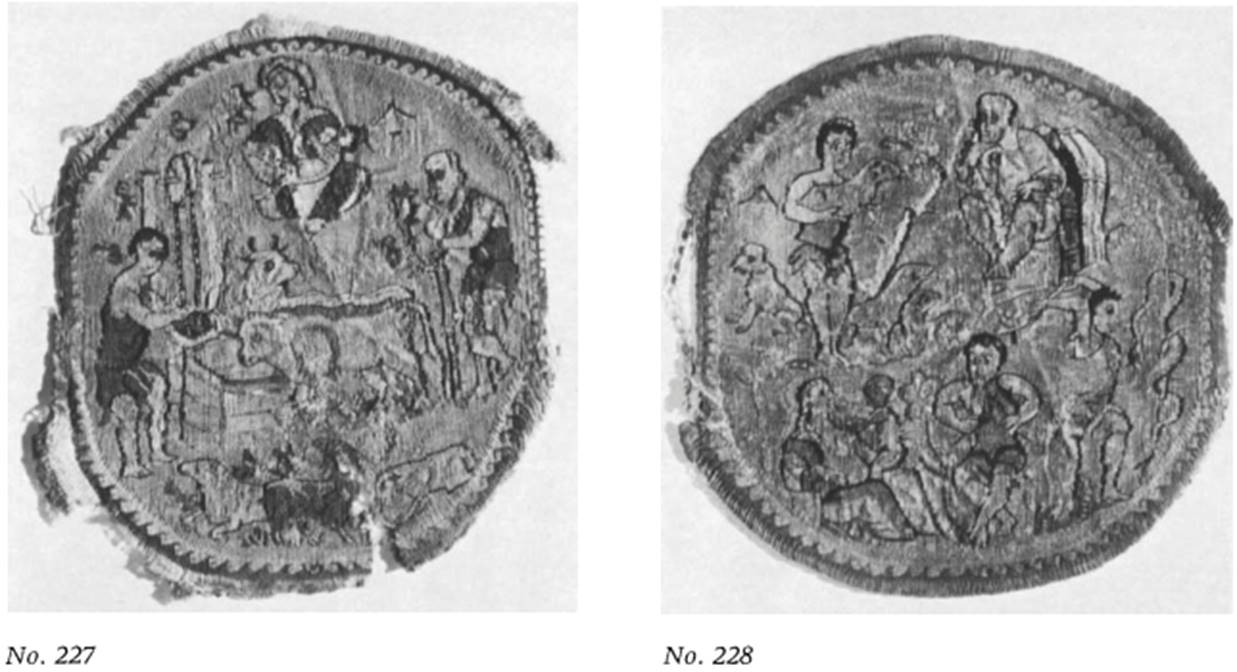Four roundels with bucolic scenes. Egypt (?), 5th century. Wool
The four roundels woven in wool once decorated a garment. In an unusually refined technique, they depict charming bucolic scenes framed by a classical wave pattern. They derive from illustrations of a vast wealth of bucolic poetry, although the precise text is apparently not preserved. Certain features reflect the romance of Daphnis and Chloe by Longus.
Each of the four medallions is filled with a variety of motifs. The first depicts at the top a mother sitting cross-legged on the ground and nursing her child, a figure found also on sarcophagi (no. 237). At the left a young shepherd clad in the tunica exomis draws a bucket from a well, carefully rendered with an elaborated superstructure. One cow is drinking and another waits her turn.

At the right an old, bald-headed shepherd with crossed legs leans in a relaxed pose on his staff, supporting his head with his right hand. At the bottom, as on the exergue of the silver plate no. 231, a flock of sheep is peacefully resting.
In the second medallion, at the upper left, a young shepherd, surrounded by his flock and a dog, carries a newborn lamb in his arms, like the Nubian boy in no. 235 or the figure of April in the sixth-century calendar mosaic at Argos (Aker- strom-Hougen, 1974, I, p. 25, fig. 9; II, pi. 1), and he offers it to an old shepherd, who sits anticipating the gift in front of his thatched hut. Below, and to the left, a mother, leaning backward, plays with her child riding on her leg (cf. the motif on sarcophagi [Gerke, 1940, p. 100, pi. 23, fig. 3]). Next to her, a shepherd sits frontally playing the aulic flute, and, at the right, a youth kills with an axe a snake that coils up a tree, a motif inspired by Heracles, who clubbed to death the serpent in the apple tree of the Hesperides.
The upper part of the third medallion is occupied by a boy stretched out on his stomach, playing the flute, while his dog listens. Below, a dog affectionately licks the left ear of a babe seated on the ground. The babe reaches out for his mother, who approaches from the left, dressed in a long garment and a high-girt tunic. She carries a second, still younger babe, slung on her back in a kerchief held by her left hand and goads with a stick in her right hand a flock of sheep and goats in front of her. This shepherdess recalls the same type as the one on the silver plate in Berlin (no. 231). Opposite her an old shepherd, sparsely clad, leans on his staff, watching her coming.
The fourth medallion shows the preparation of a meal and the following banquet. Three shepherds dressed only in loincloths are reclining around a low table, one of them reaching out for the plate on the table, which bears the head of a slaughtered animal, while a dog below eagerly awaits his share. No doubt they are telling each other stories like those we know from bucolic poetry. In the bottom scene, a shepherd skins the slaughtered animal that hangs on a tree, while another one builds a fire under a kettle. Between them is a large ornamented vessel, probably for wine. Similar banquet scenes, mostly with hunters, are to be found in mosaics, like those of Piazza Armerina (Gentili, 1959, pi. xxi).
While these bucolic scenes—which we have seen on sarcophagi, silver plates, and textiles— had their origin in Hellenistic times, they became very popular in the fourth and fifth centuries, a period when perspective yielded to paratactical arrangements. Some bucolic elements were used for calendar illustration (cf. the Argos mosaic [Akerstrom-Hougen, 1974,1]) and as such survived through the Middle Ages. Bibliography: Thompson, 1971, no. 4.
Date added: 2025-08-31; views: 81;
